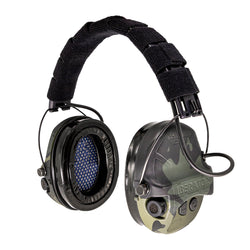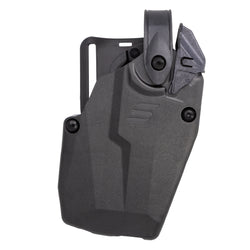Glock has ruled the handgun market for decades. Most law enforcement agencies carry Glocks, and a startling number of military forces have adopted them. It’s like Marsha from the Brady Bunch—it’s all about Glock. This has given rise to a number of guns with similar features proclaiming themselves to be Glock killers.
What’s a Glock Killer?
Glock killers copy many of the basic design features from Glock. They are polymer-frame, double-stack, striker-fired pistols that come in full-size, compact, and subcompact designs.
These days, they are typically 9mm guns, but that doesn’t fully eliminate other calibers.

Today, we are going to examine the current market of Glock killers and discuss where they beat Glock and where Glock beats them.
With that in mind, it would get really easy to repeat myself over and over in some categories, so before we dive into individual guns, let’s discuss where Glock always wins and where Glock loses.
Where the Glock Beats Them All
The “Does it take Glock mags?” stereotype exists for a reason. Their magazines are reliable, affordable, and available in various capacities. Glock always wins the magazine battle.

Glock will always win in a fight when it comes to aftermarket parts. Their dominance over the market has generated a massive ecosystem of guns, gear, triggers, and more. This has left us with a glut of aftermarket capability to turn a Glock into whatever you want.
Where Glock Gets Beat
The fact that Glock is in its Gen 5 configuration and still uses the cheapest, crappiest iron sights is beyond me. Factor in another $50 to $100 to replace your sights when you buy a Glock. As far as I know, every Glock killer on this list comes with better sights.
Now, let’s take a look at five Glock killers.
FN 509
The 509 wasn’t FN’s first striker-fired gun, but it was the first modern one that didn’t suck. (I’m looking at your FN Forty-Nine.) FN developed the 509 for the Army’s MHS contest, and while it lost the MHS, it’s seen success, including replacing Glocks with the LAPD.
The 509 series has grown into multiple calibers and sizes, including the big boys, .45 ACP and 10mm.

The 509’s growth has made it a fairly popular design. It’s found a role to fill as a duty gun, a concealed carry gun, and even moved into the competition world. The 509 series has taken its title as a Glock killer seriously.
Where it Beats Glock
The modular system on the FN 509 still uses plates but in a much better way. The plates act as spacers rather than mounts, so the optic is still mounted to the slide. The Glock system mounts a plate to the slide and the optic to the plate.
Additionally, I prefer the ergonomics of the FN 509 series, but that’s a little less objective and might not affect everyone.

Where Glock Beats It
The Glock’s trigger might not be fancy, but it’s much better than the 509’s stiff, spongy trigger. Even the competition-ready 509 LS Edge doesn’t impress me.
Walther PDP
Walther has put its back into the PDP, an evolution of the PPQ series. They designed the PDP from the ground up to be used with optics and claim the pistol’s ergonomics are primed for optics use.

It’s been adopted by German Special Operations forces and several American Police Departments. This adoption in the United States is a new phenomenon and shows that Walther has created a pistol that’s turning heads.
Where it Beats Glock
This Glock killer uses a very sturdy, recoil-resistant mounting platform. It incorporates a huge spine to resist recoil and prevent shearing. The plates attach to the gun via screws, and the optic also connects to the slide through the plate. It’s pretty sturdy.
The PDP also has a much lighter trigger that’s smoother and just fantastic.

Where Glock Beats it
The Walther PDP feels a bit snappy compared to the Glock series. Is it bore axis? A recoil spring issue? I’m not sure, but Glocks shoot softer.
Springfield Echelon
Springfield has launched numerous handgun lineups, with the XD being the closest they had to a Glock killer. In 2023, they launched the Echelon, which blew the old XD out of the water. Springfield took the removable chassis route to increase modularity.

The Echelon has been very highly reviewed, and it has impressed me. It’s even seen some adoption by American police forces, which I certainly didn’t expect. The Echelon series has certainly exceeded the XD and is a much better pistol.
Where It Beats Glock
The VIS optics system is ingenious. It doesn’t use plates but removable recoil bosses that allow you to mount a wide variety of optics to the gun without the need for plates. It’s super easy to use and super simple.

Where Glock Beats It
If your Echelon breaks, good luck finding parts to fix it. You’ll have to send it away for repairs to Springfield. Additionally, the XD series had problems that needed to be fixed, and we need more time with the Echelon to see if those issues have been smoothed out.
Glock has an established history of success.
S&W M&P 2.0
The S&W M&P series is one of the most effective Glock killers. It’s swooped up a ton of different police department contracts and is second to Glock in police sales.

The S&W M&P 2.0 smoothed a lot of the rough edges of the original M&P, delivering a solid pistol designed in various calibers and sizes. It’s one of the few guns that almost match Glock in terms of multiple calibers and sizes. They’ve even taken it further with metal frames, integrally-comped models, and more.
Where It Beats Glock
Like many of these guns, the optics mounting system is better. It uses plates, but the optics attach to the slide through the plate. Also, the optics-ready models come with suppressor-height sights for cowitnessing, which is a really lovely touch.
Where Glock Beats It
The Glock trigger smashes the M&P trigger. Something about a hinged trigger drives me crazy, and the S&W M&P 2.0 really likes its hinged trigger.
CZ P10
Last but not least, the hipster’s Glock killer comes from CZ. The P10 series comes in three sizes and historically has had a .40 S&W option, but it seems to be all 9mm now. I know of no American police or military adoption of the P10 series, but it has a cult-like following.

Bias alert, I’m a part of that cult. The P10 series does everything I want Glock to do, but that doesn’t make them true Glock killers. The P10 does a great job of smoothing out the rough edges of most striker-fired pistols and offers a refined and underrated option.
Where It Beats Glock
Off the bat, it’s better ergonomically. I mean this in both a subjective and objective way. In terms of subjective design, I like the slim grip and the control placement.
Objectively, the slide release is larger, easier to reach, and easier to use. The scallops in the slide are deeper, making the slide easier to grab when using an optic.

Optics-ready models come with suppressor-height sights, which is a nice touch. The P10 series is also friendlier to the budget, and who doesn’t want to save some money?
Where Glock Beats It
Glock offers a smaller, lighter pistol. If we compare the Glock 19 to the P10C, you’ll see it’s several ounces lighter, shorter, and, at certain points, even thinner.
Why Does Glock Still Wear the Crown?
It’s hard to unseat the king. Glock fought hard to convince folks that a polymer frame was tough enough and that striker-fired triggers were more consistent and easier to train with.

They build simple but highly reliable guns and sold them for a very fair price. They make a wide variety of handguns in a variety of sizes, and while they can be slow to adapt to the market, they focus on dependability.
Lots of killers are coming at Glock, but Glock doesn’t seem too fazed.









